
The stamen is the pollen-producing reproductive organ of a flower. Collectively the stamens form the androecium.

The perianth is the non-reproductive part of the flower, and structure that forms an envelope surrounding the sexual organs, consisting of the calyx (sepals) and the corolla (petals) or tepals when called a perigone. The term perianth is derived from Greek περί and άνθος, while perigonium is derived from περί and γόνος . In the mosses and liverworts (Marchantiophyta), the perianth is the sterile tubelike tissue that surrounds the female reproductive structure.

France Staub was a Mauritian ornithologist, herpetologist, botanist, and conservationist.

Dicentra pauciflora is a species of flowering plant in Dicentra, the genus containing the bleeding-hearts. Its common names include shorthorn steer's head and few-flowered bleeding-heart. This perennial wildflower is native to the US states of Oregon and California, where it grows high in the mountains in gravelly soils. This is a short bleeding-heart, approaching 10 centimeters in maximum height. From a rhizome beneath the soil it extends several erect petioles, each holding a leaf divided into leaflets which are each divided into smooth, fingerlike lobes. It also erects a thin stem which is topped with an inflorescence of one to three nodding flowers. Each flower is a shade of pink or purple to white, with two curving outer petals flexed back against the flower, and inner petals extended straight outward. The fruit is a capsule just over a centimeter long. The specific epithet pauciflora, refers to the Latin term for 'few flowered'.
Cynanchum staubii is a rare coastal plant from the subfamily Asclepiadoideae within in the family Apocynaceae. It is endemic to the Îlot Fourneau and the Ile aux Aigrettes, two islets off the coast of Mauritius. The species epithet commemorates Dr. France Staub, an ornithologist, herpetologist, botanist, and conservationist from Mauritius who collected the holotype in 1965.

Jean Marie Bosser, sometimes listed as Jean-Michel Bosser was a French botanist and agricultural engineer who worked extensively in Madagascar and Mauritius.

Secamone volubilis is a species of plant in the family Apocynaceae. It is native to the islands of Réunion and Mauritius in the Indian Ocean.
Oeceoclades flavescens is a terrestrial orchid species in the genus Oeceoclades that is endemic to northeastern Madagascar. It was first described by the French botanists Jean Marie Bosser and Philippe Morat in 2001. The type specimen was collected in 1954 from the wet undergrowth of a coastal forest near Maroantsetra; it is the only known collection of this species. The specific epithet flavescens refers to the pale yellow flowers.
Oeceoclades longebracteata is a species of terrestrial orchid in the genus Oeceoclades that is endemic to southwestern and south-central Madagascar. It was first described by the French botanists Jean Marie Bosser and Philippe Morat in 2001. The type specimen was collected in 1970 by Jean Marie Bosser from dry forest undergrowth near Tsaramasao, 20 km (12 mi) south of Sakaraha. The specific epithet longebracteata refers to the long bracts found along the inflorescence.

Passiflora cinnabarina, commonly known as red passionflower, is a species of flowering plant in the family Passifloraceae and is endemic to south-eastern Australia. It is a climber or scrambler with three-lobed leaves and red flowers.
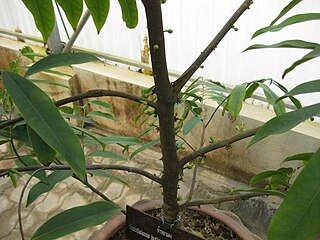
Goniothalamus laoticus is a species of plant in the family Annonaceae. It is native to Laos and Thailand. It was originally described by the French botanists Achille Eugène Finet and François Gagnepain using the basionym Mitrephora laotica. In Thailand it is commonly called Khao Lam-dong and is used as a traditional medicine.
Goniothalamus tamirensis is a species of plant in the family Annonaceae. It is native to Cambodia, Laos, Peninsular Malaysia, Thailand and Vietnam. The French botanists J.B. Louis Pierre and François Gagnepain, who first formally described the species, named it after the region in Cambodia it was collected from, which they record as “monts Tamir”.

Ranunculus allegheniensis is a species of flowering plant in the buttercup family, Ranunculaceae. Its common names include Allegheny Mountain buttercup and Allegheny crowfoot.
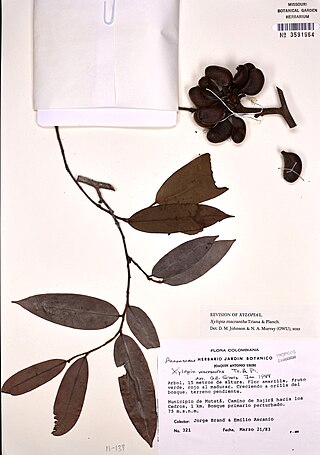
Xylopia macrantha is a species of plant in the Annonaceae family. It is native to Colombia, Costa Rica and Panama. José Jerónimo Triana and Jules Émile Planchon, the botanists who first formally described the species, named it after its large flowers.
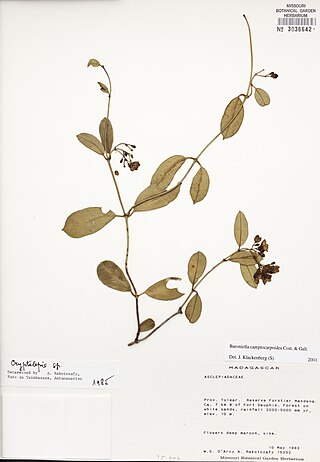
Baroniella camptocarpoides is a species of plant in the Apocynaceae family. It is endemic to Madagascar. Julien Noël Costantin and Ernest-Isidore Gallaud, the botanists who first formally described the species, named it after its resemblance to, but distinctiveness from, plants in the genus Camptocarpus.
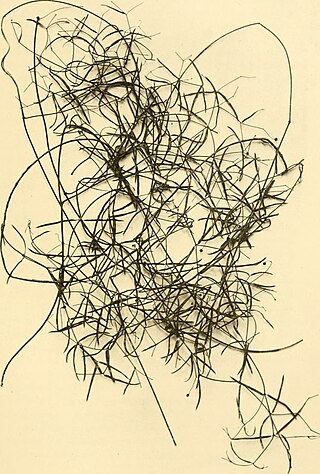
Baroniella linearis is a species of plant in the Apocynaceae family. It is endemic to Madagascar. Pierre Choux, the botanist who first formally described the species using the synonym Baseonema lineare, named it after its narrow leaves.
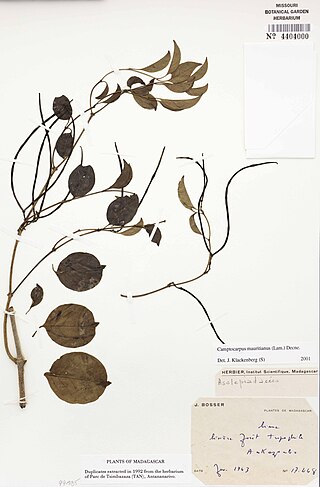
Camptocarpus mauritianus is a species of plant in the Apocynaceae family. It is native to Comoros, Madagascar and Réunion. Jean-Baptiste Lamarck, the naturalist who first formally described the species named it, using the synonym Cynanchum mauritianum, after the region of the Indian Ocean that includes the island of Mauritius, although the type specimen he examined did not list a specific location.

Chlorocyathus lobulata is a species of plant in the Apocynaceae family. It is native to the Cape Provinces of South Africa. Hendrik J. T. Venter and Rudolf L. Verhoeven, the botanists who first formally described the species named it, using the synonym Raphionacme lobulata, after the distinctive lobes of the corona of its flowers.

Chlorocyathus monteiroae is a species of plant in the Apocynaceae family. It is native to Angola, Kenya, Mozambique, Namibia, South Africa, Tanzania and Zimbabwe. Daniel Oliver, the botanist who first formally described the species named it after Rose Monteiro who collected the specimen he examined from Maputo Bay.

Camptocarpus semihastatus is a species of plant in the Apocynaceae family. It is native to Madagascar. Jens Klackenberg, the botanist who formally described the species named it after the distinct coronal lobes of its flowers that resemble half the head of a spear.

















